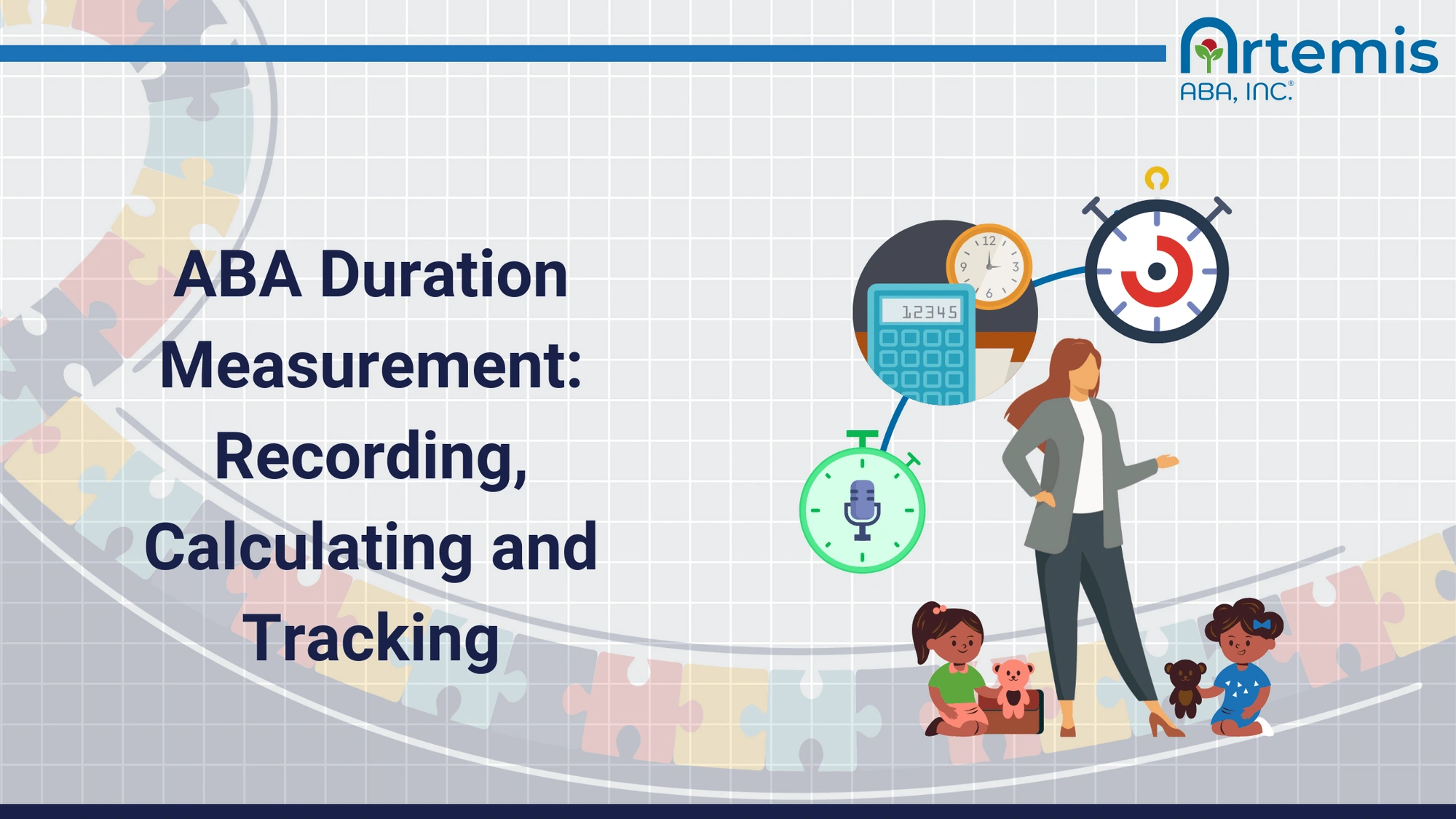Monday to Friday, 7 AM – 7 PM CST.
If you're reaching out outside these hours, please submit a support ticket—our team will respond as soon as possible.

ABA Duration Measurement: Recording, Calculating and Tracking
Behavior is complex, and measuring its dimensions is crucial to ABA. In this comprehensive guide on duration data, learn how to record, calculate, and track duration data. Understand how you can use duration data in evidence-based treatment decisions.
Inside this article:
- What is duration recording in ABA?
- How do you record ABA duration data?
- Duration data vs. frequency and latency data
- Examples of duration data
- How electronic data collection simplifies recording duration data
What is Duration in ABA?
Duration data in ABA measures how long a patient engages in a specific behavior. ABA professionals use duration data to track behaviors with a clear start and end. Duration data is important in understanding behavior patterns.
Duration measures how long a behavior lasts. Examples of duration data in an everyday context include how long you spend exercising, reading, driving to work, writing, or any other activity. In ABA, duration specifically refers to how long a defined instance of behavior lasts.
Duration data provides insights into behavior that has a discrete start and end. For example, if a student throws temper tantrums every day for 20 minutes, it may seem more problematic than a student who throws a temper tantrum for two minutes once every two weeks. You can collect duration data continuously, over extended periods, or discontinuously, during specific observation periods.
Duration data, along with frequency and latency data, form the foundation of ABA data collection and analysis central to ABA. These data points are crucial in effectively analyzing behavior patterns, identifying problems, and evaluating behavior intervention plans.
Key Takeaways:
- Duration data in ABA measures how long a child engages in a behavior.
- Duration, along with latency and frequency, is a foundational type of data in ABA.
- It’s best to measure duration data for behaviors with a clear start and end.
- Recording duration data can be challenging when a technician isn’t working with the child individually.
- Electronic data collection simplifies recording and analyzing ABA duration data
Duration vs. Latency Data in ABA
In ABA, duration measures how long a behavior lasts, and latency measures the time it takes to start a behavior after a prompt. Duration looks at behavior time, and latency focuses on response time. BCABAs use both types of data to analyze behavior.
For example, a BCBA might ask a student to raise their hand, sit quietly, or complete a task. The BCBA would track duration if they wanted to know how long the student engages in the specific behavior after the prompt. On the other hand, the BCBA would measure latency data if they wanted to know how long it took for the student to initiate the behavior after receiving the prompt or cue.
By using both duration and latency data, BCBAs can gain valuable insights into their clients' behavior patterns, response times, and overall progress.
Duration vs. Frequency Data in ABA
In ABA, duration captures the length of time a behavior lasts. In contrast, frequency data measures how many times a behavior happens. Unlike duration data, frequency data doesn’t include a time interval.
Duration data and frequency data are connected in ABA. By measuring duration, you can also calculate frequency within the observation period. For example, if you measure the duration of a behavior five times in a day, the frequency of that behavior for the day is "five."
However, measuring frequency alone does not provide duration information. BCBAs often collect frequency and duration data to get a more complete picture of behavior.
What is Duration Recording in ABA?
In ABA, duration recording measures the length of time a behavior lasts. This tells BCBAs how long a patient engages in a specific behavior. BCBAs use this data to guide interventions for increasing positive behavior and decreasing negative behavior.
How to Record ABA Duration Data?
To record ABA duration data, first define the target behavior in a measurable way. When the behavior occurs, use a stopwatch or timer to measure when it begins and ends. Start the timer when the behavior starts and stop it when it ends.
To accurately record ABA duration data, defining the specific target behavior is crucial. For instance, you may focus on measuring the duration of verbal self-stimulating behavior, such as humming, while excluding repetitive speech or physical self-stimulation.
You can use tools like a wristwatch, stopwatch, or smartphone to record duration data. Some practitioners even record sessions and review them later to measure the duration of the target behavior. It's important to be well-prepared and have a readily available stopwatch and datasheet.
Here's a simplified step-by-step guide for recording ABA duration data:
- Begin timing when the behavior starts, anticipating the triggers or antecedents.
- Stop timing when the behavior ends.
- Record the patient's duration in the behavior (the time elapsed on your stopwatch.)
Examples of Duration Data in ABA
Examples of ABA duration data include measuring how long any behavior lasts. Specific examples include temper tantrums, self-stimulation, and on-task behavior. Sometimes, it’s easy to mistake latency and frequency data for duration data.
BCBAs use duration data to measure behavior across the four categories of behavior function. These include sensory behavior, escape-based behavior, attention-based behavior, and tangible-based behavior. Examples of duration data for each function can provide valuable insights and inform interventions.
Here are examples of duration data for each of the four functions of behavior, along with examples of data that people may mistakenly consider as duration data:
How Do You Calculate Duration in ABA?
In ABA, duration is the time elapsed from the start to the end of a behavior. Record the start and end times to calculate it, then subtract to find the total duration.
Duration data refers to the length of time a behavior occurs, from start to finish. Technicians typically measure this data over longer observation periods, such as a few hours or a day. BCBAs utilize single instances of duration to graph trends over time. With multiple instances, we can calculate total and average duration.
How Do You Calculate Total Duration?
To calculate total duration, sum up all the duration data points. Total duration tells you how long the child engaged in the behavior during the observation period. ABA therapists also use total duration to see whether the behavior strongly impacts the child’s day.
Calculating total duration is straightforward: Sum up all the duration data points. For instance, if you observed a child rocking back and forth in his seat four times during one 8-hour school day, with durations of 30 seconds, 20 seconds, 25 seconds, and 15 seconds, the total duration would be 30 + 20 + 25 + 15, which equals 90 seconds.
Total duration is a great measure of how impactful behavior is on a child's day. For example, in this case, behavior that lasts 90 seconds over an 8-hour observation period doesn't seem too critical. But, if the total duration was much larger, say one or multiple hours, the BCBA might decide an intervention is necessary.
How Do You Calculate Average Duration?
To find the average duration, divide the total duration by the number of behavior instances. It shows how long the child typically engages in the behavior. ABA therapists use it to see if the behavior's duration is consistent or shows any patterns.
You can calculate the average duration by taking the total duration and dividing it by the number of instances (or frequency) of behavior over the observation period. Let’s repeat the above data to calculate the total duration a child rocks back and forth in his seat. In that example, our total duration is 90 seconds, and the frequency is four. That means that the average duration is 90 seconds divided by four instances, which equals 22.5 seconds. This means that, on average, the child rocks in his chair for 22.5 seconds before stopping.
Average duration helps the BCBA understand the behavior patterns: Does it vary considerably, or is the duration consistent?
The BCBA can use both total and average duration to determine whether an intervention like discrete trial training (DTT) is working. For example, if the BCBA wants to reduce the duration of behavior, they will hope to see both total duration and average duration decrease during and after the intervention period.
ABA Duration Data Sheet Templates
Our ABA duration data sheet template gives you everything you need to collect duration data and calculate the total and average. Explore this free, printable template to see what collecting duration data is like.
Download our free and printable ABA duration datasheet template
How to Graph ABA Duration
To graph ABA duration data, collect behavior duration data, and create a graph. Plot durations on the y-axis and time on the x-axis. Use the graph to visualize patterns and changes in behavior over time.
To graph ABA duration data effectively, follow these steps:
- Collect duration data: Begin by meticulously recording the duration of each behavior instance during a planned observation period. Ensure accuracy and consistency in data collection, as this will directly impact the reliability of the graphed results.
- Choose the right graph: Determine your data's most suitable graph type. The most common option for representing duration data is a line graph, where durations are plotted on the y-axis and time on the x-axis.
- Use electronic data collection: If you can access electronic ABA management software, use its graphing capabilities. Such software allows for automated data entry and streamlines graph creation, saving time and reducing the risk of manual errors.
- Manually graph: If you are not using electronic software, you can still create a graph manually using graph paper or spreadsheet software like Microsoft Excel. Plot each behavior's duration at the appropriate time points to construct a visually informative graph.
- Set the time interval: Consider the appropriate time intervals for your graph. Depending on the observation period and the data granularity, you may choose intervals such as minutes, hours, days, or even weeks. Your chosen scale will change how easily you can read and interpret the graph. Again, electronic data collection will make this decision for you and let you customize the interval to see how the data looks over different periods.
- Highlight interventions: If you are implementing interventions during the data collection period, use the graph to highlight these intervention periods. For example, manually write in when you applied an intervention, or add it with your practice management software. This practice will help you assess the intervention’s impact on behavior duration and identify positive changes.
Why Do We Graph ABA Duration Data?
Graphing duration data gives BCBAs a comprehensive understanding of the behavior's patterns. It also helps them grasp the problem’s magnitude. Additionally, it helps measure the effectiveness of interventions.
Jester explains that graphing brings the data to life and makes it easier to understand how the behavior fits into the child’s day.
“A ten-second tantrum will affect the life of a child much differently than a temper tantrum that lasts for ten minutes,” explains Jester. “Graphing the data shows us the level of impact the behavior may be having on the child and their stakeholders. If the duration data shows us that this behavior is significantly disrupting the day’s activities, we can confidently apply an intervention plan and monitor the behavior. If the duration is short, and the behavior occurs infrequently, there may be other target behaviors we will prioritize first.”
Graphing the duration data provides BCBAs with valuable insights into the broad patterns of the behavior, helping them answer questions such as whether the behavior typically lasts for around the same time on different occasions.
For example, if a BCBA plots duration data and notices that the data points are close together, this indicates that the behavior usually lasts for the same amount of time. However, a wider spread suggests that something else, like an environmental or social trigger, makes the behavior last longer.
Armed with this knowledge, the BCBAs can create a targeted intervention plan. Of course, graphing will be instrumental in monitoring the plan as well.
“ABA relies on visual analysis — graphing duration data allows us to monitor the level, trend, and variability of duration to ensure that we have effective interventions in place,” says Jester.
When Should You Graph ABA Duration Data?
BCBAs should graph ABA duration data whenever they want to visualize behavior patterns. Graphing highlights behavior changes and helps to assess whether interventions are working. Overall, a graph allows insights to pop out more easily.
What are the Advantages of Duration Recording?
Duration recording in ABA has many advantages. It measures how long behaviors last, making analysis more precise. It also helps BCBAs identify patterns and trends in behavior over time. Also, BCBAs use duration data to monitor whether behavior interventions are working.
Here's a summary of the advantages of duration data:
- Precise measure of behavior:
“Duration is a continuous measure,” Jester says. “When collecting duration data, we capture every instance of the behavior. As a result, we get a complete picture of the behavior.” - Useful in assessing behavior with discrete start and end:
“Duration data is useful when the behavior has a distinct beginning and end because that is how we track the behavior,” Jester says. “We start the clock when the behavior starts and stop the clock when the behavior ends.” - Provides information on intensity:
Duration recording captures how long a behavior occurs and provides information about the behavior's intensity or magnitude. Usually, but not always, BCBAs consider behavior with longer duration to also be more intense. For example, a tantrum lasting for 10 minutes may be considered more intense than a tantrum lasting for one minute. - Provides information on frequency:
Duration data not only provides insights into how long a behavior lasts but also its frequency. For example, if you observe a student engaging in a behavior four times, each lasting 15 seconds, you know the frequency is four within that period. - Helps compare the severity of different behaviors:
Duration recording allows BCBAs to compare the durations of multiple behaviors. This comparison helps compare behavior assessments. BCBAs can use the data to determine which behaviors affect the individual's life more and may require immediate attention.
What are the Limitations of Duration Recording?
Duration data has some limitations. It can be time-consuming and difficult to collect data accurately. Also, it only works for behaviors with a discrete beginning and end. Finally, it doesn’t provide any information about the latency of a behavior.
Here’s a detailed list of the limitations of duration data.
- Time-consuming data collection:
Jester knows firsthand how time-consuming duration data can be. Since it requires careful observation of behavior from start to finish, it limits the technician’s ability to attend to other children simultaneously. "Duration recording significantly adds to the workload of data collection," emphasizes Jester, "and might be better suited for one-on-one service." - Limited insight for indiscrete behaviors:
Indiscrete behaviors don’t have a beginning or an end, making measuring duration inherently difficult.
Jester points out that “concrete operational definitions based on the individualized behaviors can help for indiscrete behaviors without a clear start and end.”
"Behaviors like fidgeting or continuous vocalizations can be challenging to track because they do not have clear start or endpoints," explains Jester. "In such cases, the BCBA can utilize strict 'operational definitions' – offering a specific and precise description of the behavior. The more detailed the definition, the more effective it becomes."
For instance, a BCBA might define fidgeting as follows: "Fidgeting is defined as any repetitive and small-scale physical movements exhibited by an individual during periods of rest or inactivity." In this scenario, the behavior would be considered "ended" once the child begins playing. - Doesn’t capture all behavior dimensions:
Relying solely on duration data may overlook other essential dimensions of behavior, such as latency. Latency refers to the time elapsed between presenting a specific stimulus or event and initiating the behavior. Understanding latency is crucial for analyzing response time and identifying antecedents that trigger the behavior.
While duration recording has its limitations, it remains a valuable tool in ABA, especially when BCBAs complement it with other data collection methods to provide a complete picture of behavior and guide evidence-based decision-making.
ABA Duration Recording Best Practices
Define the behavior clearly to follow best practices for ABA duration recording. Also, make sure that technicians have the time they need to record data accurately. Most technicians prefer to record data electronically.
ABA professionals find duration data fundamental to their work. To maximize what the data can do for you, it’s best to follow these general best practices.
- Clearly define the behavior being recorded:
Jester emphasizes that “thoughtful, individualized operational definitions that remove the ‘gray’ from data collection are key. Each type of behavior (for example, kicking, screaming, throwing a tantrum) may have different topography for each child, so ensure that your definitions are clear.” - Training:
Provide thorough training to data collectors to ensure they understand the operational definitions and use data collection tools proficiently.
“You want the data collector to feel 100% confident when to start the clock and when to stop the clock,” Jester notes. - Ensure that the data collector has enough time and energy:
Duration data requires that the data collector intently focuses on the child and behavior of interest. Otherwise, they might miss a behavior incidence, and the data will be inaccurate. - Set appropriate observation periods:
If you’re collecting your data discontinuously, choose appropriate observation periods. Avoid excessively long or short observation periods, which may lead to data collection fatigue or missed behavior instances. - Note the length of the observation period:
BCBAs that note the length of the observation period, whether it’s continuous or discontinuous, can also glean frequency data from the duration data. - Consider video recording:
Video recording can be a valuable addition to duration data collection, especially for complex or infrequent behaviors. It offers the advantage of reviewing and verifying data later, ensuring accurate observations even when data collectors have multiple responsibilities to handle. Videos allow focused data collection on the child and behavior in question, enhancing data accuracy and reliability. - Collect duration data electronically:
Use electronic data collection to record and analyze duration data in real time. Electronic platforms streamline the process, minimize errors, and enhance efficiency by providing instant data storage and analysis.
Using Electronic ABA Data Collection for Duration Data
Electronically collecting ABA duration data makes every part of the process easier. First, it’s easier to record data in real time. Also, many systems automatically graph data to inform intervention plans. Electronic ABA data collection ultimately improves the effectiveness of duration data.
As a whole, ABA Practice Management is going digital. Like other aspects of ABA, data collection has been revolutionized by this transition to electronic practice management.
Electronic data collection enables technicians to collect real-time data, track time precisely, and automatically create graphs. Adopting digital solutions can significantly enhance the accuracy, efficiency, and analysis of duration data. And that ultimately improves the effectiveness of behavior intervention.
Here’s a list of the major ways that electronic data collection can help ABA professionals collect and analyze duration data:
- Streamlines real-time data entry:
For most people, recording data in real time on an electronic device is far easier than by pen and paper. When the task becomes easier, it’s more likely that the data will be more accurate. - Built-in time tracking:
Digital tools offer features to capture precise time stamps, so you don’t need to also worry about operating a stopwatch — the ABA data collection platform will handle it for you. - Software automatically integrates the data into the practice management system:
The best ABA practice management software incorporates electronic data collection. It automatically uploads duration data with all relevant client information to a centralized location. With everything in one place, BCBAs can focus on holistic behavior management instead of searching for scattered data. - Automated duration calculation:
Electronic platforms can automatically calculate metrics like average duration or extrapolate frequency data from duration data and the total observation time. - Instant graphing and analysis:
Electronic data collection allows for the easy generation of graphs and charts, visually representing behavior durations over time for quick analysis. Most programs also highlight key analysis points, like the variance from the mean duration. - Customizable behavior categories:
Most electronic data collection systems can track multiple behavior categories and their respective durations in one streamlined platform.
Comprehensive, Integrated ABA Data Collection
You can efficiently track client progress with Artemis ABA software. Record behavior duration, latency, and frequency in one place. Customize the solution for your ABA practice needs. Access and analyze data seamlessly with our connected system.
Artemis ABA practice management software consolidates behavior duration, latency, and frequency data in one convenient location. ABA therapists can promptly access this data, enabling informed treatment decisions and meticulous monitoring of client progress.
When it comes to duration data, Jester explains how it works: “Artemis collects duration data by allowing the technician to capture duration right in the system. The duration is graphed and stored for the client, readily available for visual analysis by the supervisor on the case, whether they decide to look in person at the clinic or remotely.”
What sets Artemis ABA apart is its exceptional flexibility as a practice management solution. Thoughtfully designed by ABA experts, the software can be tailored to match the unique needs of your ABA practice.
Unlike other ABA software that might necessitate complex integrations, Artemis ABA boasts a reliable and connected ABA data collection system, seamlessly storing all your data in one accessible repository, along with patient notes and everything else you need. This cohesive approach ensures effortless data access and comprehensive analysis, empowering therapists to deliver personalized and effective interventions.
As a sophisticated solution, Artemis becomes the ideal choice for ABA clinic owners aiming to elevate their practice. By simplifying data management and streamlining workflows, Artemis allows technicians to focus on patient health and facilitates exceptional treatment outcomes.
Schedule Your Walkthrough
Please enter your details and one of our team members will contact you shortly
See Artemis in Action
Enter your information below















%201.webp)


